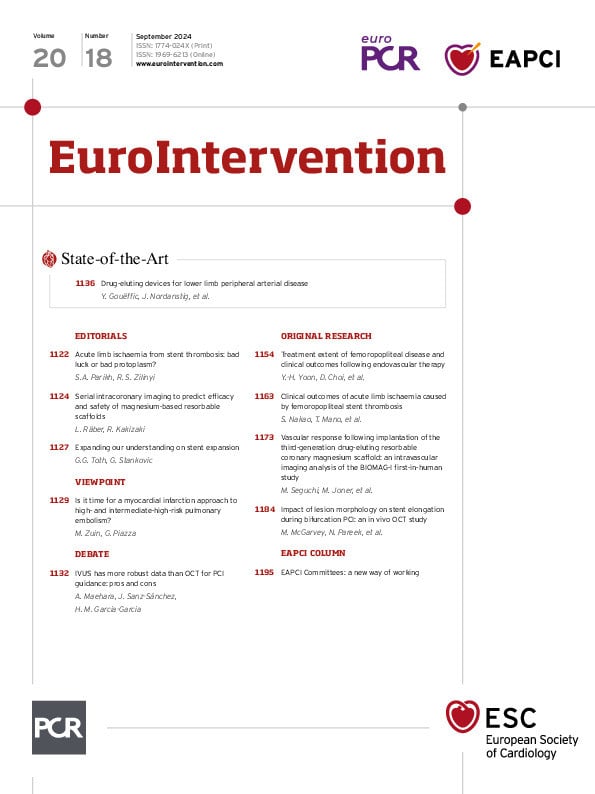Bifurcation coronary stenoses represent complex three-dimensional structures, in which the percutaneous coronary intervention (PCI) has to respect different diameters and angulations to achieve good results in all three involved vessel segments. Therefore, while bifurcation PCI is considered as a complex procedure for interventionalists, it is a substantial technical challenge for the tubular stent devices as well.
Finet’s law1, describing the correlation between the diameters of the proximal main branch, the distal main branch and the side branch, is the cornerstone of understanding bifurcation anatomy. It highlights the existing diameter discrepancies between the three branches, especially the distal and proximal main branches. This understanding has substantially shaped bifurcation PCI procedures, making the proximal optimisation technique (POT) probably the one and only inevitable step2, with large registry datasets confirming the associated favourable impact on clinical outcome3.
Accordingly, expansion capacity has become one of the most important “unique selling points” for drug-eluting stents, especially when targeting special indications in bifurcations or the left main stem, in which the diameter mismatch can be massive. This has to be tackled by proper overexpansion (i.e., POT) to avoid underexpansion and malapposition, which are associated with the risk of potential stent failure. And amazing technical advances have been achieved in this respect, resulting in some latest-generation stent platforms having special strut designs that allow 70% overexpansion and beyond.
However, while stents tend to be seen as pure tubular structures, these platforms are in reality complex designs with an organic structure of rings of crowns with connectors in between. Not being an elastic structure, the overexpansion capacity of a stent is derived from reshaping its design by stretching the crowns to reach their maximal absolute lengths, and so the number of crowns correlates with the overexpansion capacity. Importantly, and again because of not being an elastic structure, traction or compression in one spot has a marked mechanical effect on the neighbouring stent rings and even on the neighbours of the neighbours, and so on.
Therefore, there was a clear need to describe how stent platforms react to such massive overexpansion, as is typically required during POT. Bench testing offers unique insights in mechanical stent behaviour, and therefore it is considered a standard method for analysing different aspects of bifurcation techniques4. Such bench tests have shed new light on POT-related stent behaviour as well. Recent experiments have revealed that overexpansion in the context of POT results in significant elongation of the proximal stent segment. Incremental overexpansion beyond the nominal diameter resulted in gradual elongation, which reached as much as 20% when dilation went beyond the manufacturer’s recommended limit. While this was partially related to overexpansion-related deformation, other factors also clearly played a role. First, when a POT balloon is positioned with its marker at the carina, the balloon’s shoulder tends to cause the balloon to slide backwards during inflation, interacting with the stent struts and stretching them longitudinally. Second, an incompletely deflated POT balloon may exaggerate the interaction and may enhance iatrogenic elongation during balloon retrieval. Still, in vivo data were confirmatory for the elongation phenomenon, demonstrating more than 2 millimetres of elongation on average in a cohort of 36 bifurcation PCI cases in which, on average, 30% overexpansion was performed by POT.
This extent of elongation has obvious clinical relevance in terms of the (un)predictability of proximal landing accuracy5. However, it remained unclear whether this was a universal phenomenon or whether plaque composition had an impact on its magnitude.
Aiming to give an answer to that, in this issue of EuroIntervention, McGarvey et al present the results of 116 optical coherence tomography-guided left main and left anterior descending bifurcation PCIs, assessing the relation between baseline plaque composition and POT-related stent elongation6. Lesions were characterised as fibrocalcific, fibrous or lipid-rich plaques. After an average of 117% overdilation by POT, the overall stent elongation was 4.4%, equal to an absolute elongation of 1.3 mm. This was markedly higher at 6.4% in case of lipid-rich stenoses, as compared to 3.1% and 3.3% in cases of the fibrocalcific and fibrous forms, respectively. Importantly, that relative elongation is expressed with respect to total stent length, and therefore it would be even more pronounced in relation to the stent segment in the proximal main branch. Even more importantly, beyond the considerable average values, derived from a notable scatter, the elongation reached more than 3 millimetres in several procedures. And the “front runner case” showed more than 6 millimetres of lengthening!
These data suggest that “softer” plaques and less resistant vessel walls allow more stent lengthening. In addition, there are frequent clinical scenarios where the proximal main branch is totally free of any stenosis (i.e., Medina 0,x,x bifurcation), and POT can expand the stent resistance-free until reaching apposition. Speculatively, the elongation in that situation might have been even more pronounced; however, that remained unclear.
While stents are the product of cutting-edge engineering, obviously there are several non-standardised conditions in everyday clinical applications where their mechanical behaviour is hard to understand and even harder to predict. While their overexpansion capacity has become tremendous thanks to sophisticated designs, such manipulation has to pay the price of increased unpredictable structural behaviour. That has to be acknowledged and, even more importantly, detected, emphasising the importance of intravascular imaging for all cases where the stent’s capacities are stretched to its limits.
Conflict of interest statement
G.G. Toth: consultation and speaker fees from Abbott, Abiomed, Biotronik, Boston Scientific, Medtronic, and Terumo. G. Stankovic: speaker fees from Medtronic, Abbott, Terumo, and Boston Scientific.

